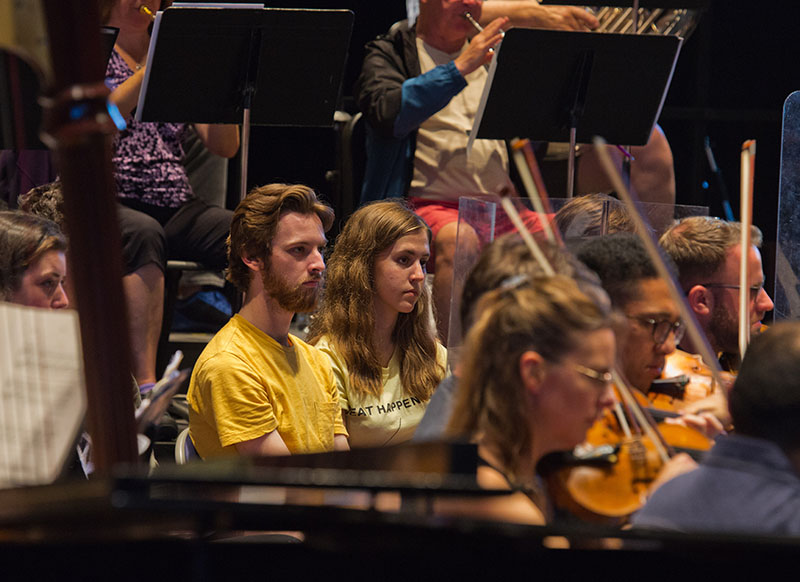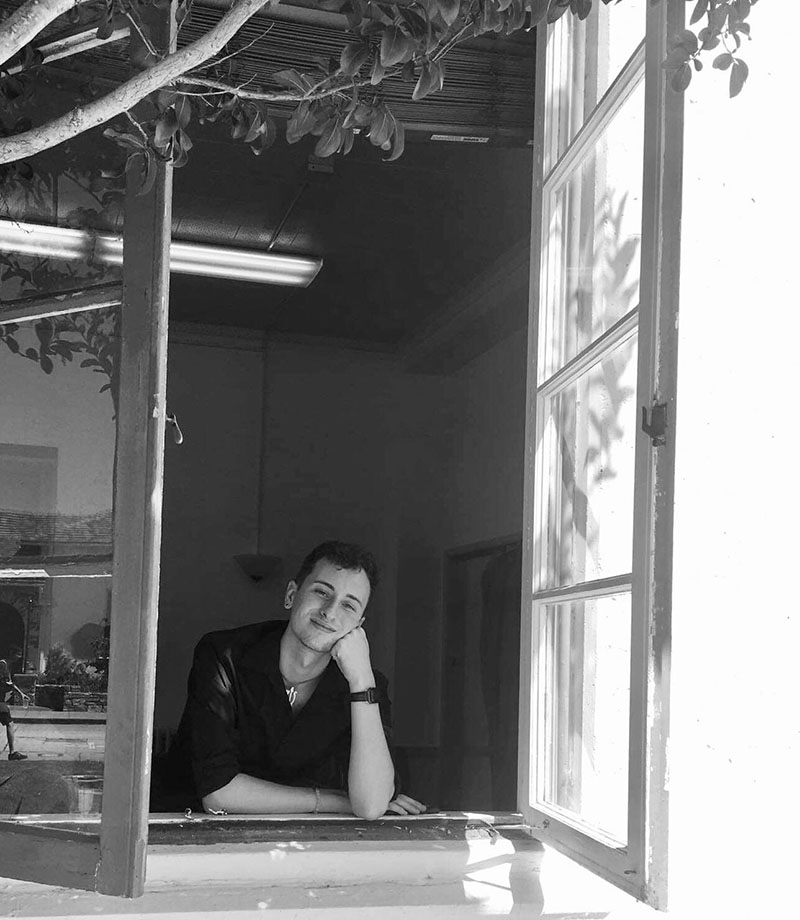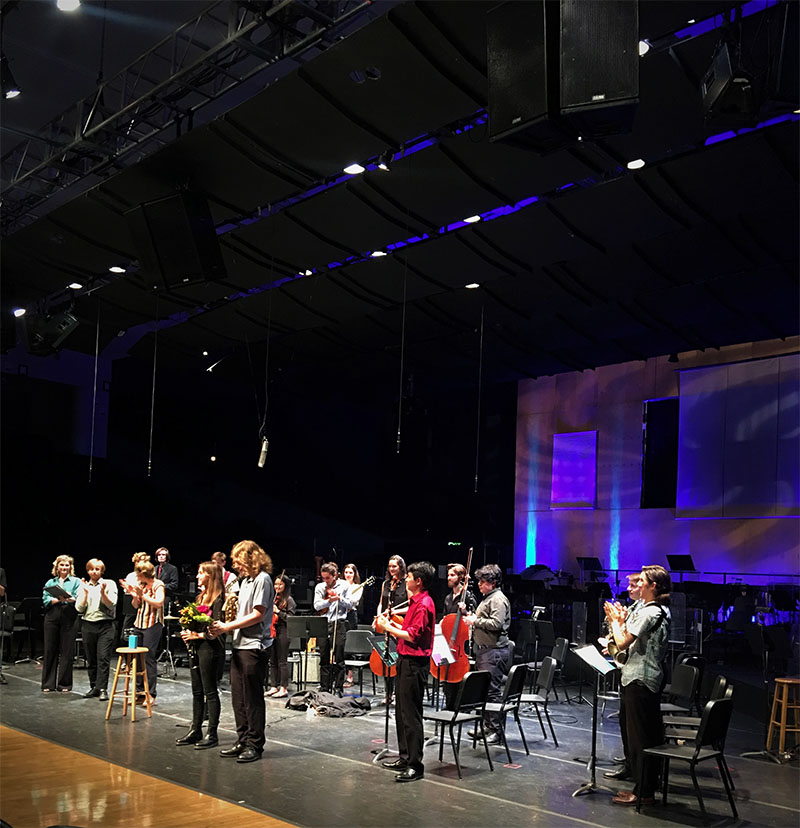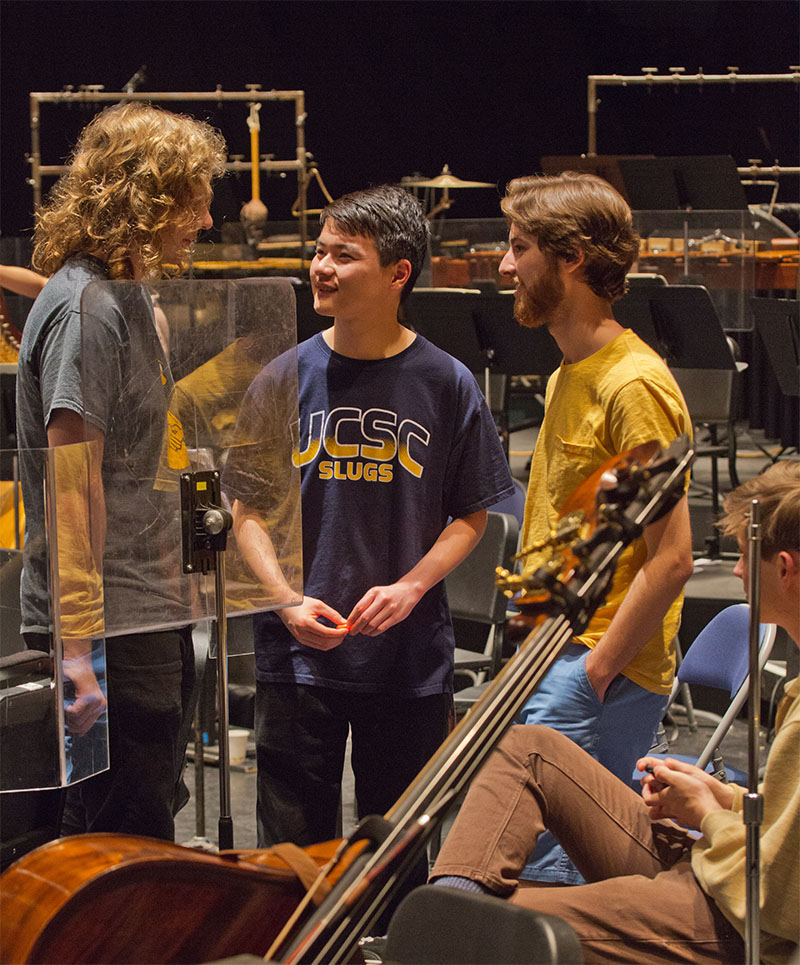
If you attended any of the concerts this season, you likely received a program book from a person wearing a blue Cabrillo shirt. Chances are, this person looked to be around the age of a high school or college student, and was a member of the Festival’s Student Staff Program. By night, these students served as ushers, but by day, they were rehearsing for hours on end for the Student Staff Concert, where they would be performing original compositions that were written and rehearsed before and during the Festival period. Members of the Student Staff Program have the opportunity to perform, compose, and conduct works; participate in masterclasses with guest artists and orchestra members; and attend the concerts as ushers. When I began working with the Festival staff and caught wind of this program, I knew that I wanted to devote a post to it. So often, programs that provide opportunities like this are limited to students who can afford them, or who have the ability to apply for the few scholarships offered. This program, however, is both free and available to anyone—and the only requirements are that you have an interest in music and are under 24.
The students involved come from a wide range of backgrounds and skillsets. This variety is one of the things that makes the program so unique. I spoke with this year’s student staff directors: Nick Uhlig, a music major at UC Santa Cruz, and Emma Nelson, a recent graduate of Kirby School (about to start at Tufts University), who touched on this aspect of the experience. Nick explained, “That’s one of the really interesting things about the Festival, is the wide variety that we get in the Student-Staff program. Like, the difference between Bennet’s and Zade’s pieces [two composers this year] [. . .] that’s very interesting to me—working in an environment where those kinds of things can coexist.” Emma described what it was like being so much younger than many of the other participants, sharing that when she joined two years ago, she was worried about potentially disappointing older students and music majors, however, after being in the directing role, she’s gained a lot of confidence: “it’s teaching me that I’m in this role because I’m responsible.” She also mentioned that it’s helpful to have Nick as a co-director—together they can tackle the jobs of communicating with eighteen other musicians (the most that the Student Staff program has ever had), organizing rehearsals, and preparing the concert. Student staff composer and third-year attendee, Michael Aoun, mentioned the importance of collaboration between students with different levels of experience, through which they have the opportunity to “learn how to communicate with their notation to musicians of different abilities and backgrounds.”
 Michael is a UC Santa Cruz student majoring in vocal performance and has participated and composed for the Student Staff Program for three years. Before the start of the Festival, I sat down with them to discuss their thoughts on how the Festival can benefit UCSC music students/musicians. They shared, “it is so informative for composers—or even if you’re not someone who is composing that year, but you are interested in being a part of new music—it’s so informative of what that process looks like. You have to be collaborating and experimenting and communicating. I think that all UCSC music students should be involved, and that’s why I’ve personally reached out to a lot of students and been like, ‘please do this festival.’” For Michael, one of the best parts of the Festival is having the opportunity to go to all of the concerts, which often serve as inspiration for their own work: “There are sounds being made by these amazing composers that I would have never thought of had I not been a part of this festival and I’m getting so many ideas as a composer myself, as a musician, as a singer, and as a person.” For Michael, the interactions between the Festival musicians and the student staff are also very important. This year, Conductor in Residence, Octavio Más-Arocas, worked closely with the Student Staff, attending many of their rehearsals and providing feedback. Cristi Măcelaru joined their rehearsals as well, giving them suggestions for how to improve their work in the short preparation period they had. The students also attended workshops with Roomful of Teeth, composer Preben Antonsen, and orchestra member Robyn Julyan. But many of the relationships built between Student Staff members and Festival artists also happen when the students have the chance to sit inside the orchestra during a designated open rehearsal. Emma and Nick explained that often when a student connects with a member of the orchestra, that person will come to the concert to see what they’re working on. For Michael, these sorts of occurrences are really important. They shared: “being there in the orchestra, getting to look at their score a little bit, and getting to talk to them—that gives me hope and that gives me permission. That allows me to feel valuable, which is very important.” Throughout our conversation, Michael emphasized the importance of building relationships between older and younger generations within the world of contemporary music: “I think that we could use the platform of the Festival to bring music to the younger generation and involve them in contemporary music, but also, we could use the Cabrillo Music Festival to connect those age groups.” Michael explained that these connections provide young artists with the chance to share both their creative work and the issues that matter to them: “we have an amazing opportunity to present new work in a way that is taken seriously, regardless of whether or not it is serious music, it’s taken seriously, and I think that it’s a venue where we could elevate those whose music isn’t taken seriously.”
Michael is a UC Santa Cruz student majoring in vocal performance and has participated and composed for the Student Staff Program for three years. Before the start of the Festival, I sat down with them to discuss their thoughts on how the Festival can benefit UCSC music students/musicians. They shared, “it is so informative for composers—or even if you’re not someone who is composing that year, but you are interested in being a part of new music—it’s so informative of what that process looks like. You have to be collaborating and experimenting and communicating. I think that all UCSC music students should be involved, and that’s why I’ve personally reached out to a lot of students and been like, ‘please do this festival.’” For Michael, one of the best parts of the Festival is having the opportunity to go to all of the concerts, which often serve as inspiration for their own work: “There are sounds being made by these amazing composers that I would have never thought of had I not been a part of this festival and I’m getting so many ideas as a composer myself, as a musician, as a singer, and as a person.” For Michael, the interactions between the Festival musicians and the student staff are also very important. This year, Conductor in Residence, Octavio Más-Arocas, worked closely with the Student Staff, attending many of their rehearsals and providing feedback. Cristi Măcelaru joined their rehearsals as well, giving them suggestions for how to improve their work in the short preparation period they had. The students also attended workshops with Roomful of Teeth, composer Preben Antonsen, and orchestra member Robyn Julyan. But many of the relationships built between Student Staff members and Festival artists also happen when the students have the chance to sit inside the orchestra during a designated open rehearsal. Emma and Nick explained that often when a student connects with a member of the orchestra, that person will come to the concert to see what they’re working on. For Michael, these sorts of occurrences are really important. They shared: “being there in the orchestra, getting to look at their score a little bit, and getting to talk to them—that gives me hope and that gives me permission. That allows me to feel valuable, which is very important.” Throughout our conversation, Michael emphasized the importance of building relationships between older and younger generations within the world of contemporary music: “I think that we could use the platform of the Festival to bring music to the younger generation and involve them in contemporary music, but also, we could use the Cabrillo Music Festival to connect those age groups.” Michael explained that these connections provide young artists with the chance to share both their creative work and the issues that matter to them: “we have an amazing opportunity to present new work in a way that is taken seriously, regardless of whether or not it is serious music, it’s taken seriously, and I think that it’s a venue where we could elevate those whose music isn’t taken seriously.”
 The Student-Staff Concert is one major way that the Festival provides a serious platform for the voices of young musicians. These musicians may or may not have had their compositions performed in a professional space before, and here, they are given total freedom to work on anything that interests them. This concert is advertised alongside the major concerts of the season and professionally recorded. Before each piece, the composers have the opportunity to describe their concepts, mirroring the format of other Festival concerts. These introductions were one of my favorite aspects of this year’s concert. I really appreciated the way that the students’ care for their work came through in their statements, which were very unique to each composer. The ensemble seemed confident and comfortable on stage, even when the pieces including improvisation, theatricality, and difficult phrasing, might have pushed their comfort zones. As an audience member, I was engaged throughout, experiencing the wide variety of intentions in each piece, and I continued to remember and reflect on the works afterward. At the beginning of the concert, Emma shared that she found this ensemble to be exceptional, and while I wasn’t here for the concerts in previous years, so did I and many other audience members I spoke with.
The Student-Staff Concert is one major way that the Festival provides a serious platform for the voices of young musicians. These musicians may or may not have had their compositions performed in a professional space before, and here, they are given total freedom to work on anything that interests them. This concert is advertised alongside the major concerts of the season and professionally recorded. Before each piece, the composers have the opportunity to describe their concepts, mirroring the format of other Festival concerts. These introductions were one of my favorite aspects of this year’s concert. I really appreciated the way that the students’ care for their work came through in their statements, which were very unique to each composer. The ensemble seemed confident and comfortable on stage, even when the pieces including improvisation, theatricality, and difficult phrasing, might have pushed their comfort zones. As an audience member, I was engaged throughout, experiencing the wide variety of intentions in each piece, and I continued to remember and reflect on the works afterward. At the beginning of the concert, Emma shared that she found this ensemble to be exceptional, and while I wasn’t here for the concerts in previous years, so did I and many other audience members I spoke with.
During the Festival weeks, I had the opportunity to sit in on some of the rehearsals and ask the composers about their concepts and processes. I share those concepts here, as well as the descriptions the students gave during the concert alongside my own observations, for anyone who is curious.
The concert opened with La Mouche by Zade Dardari, a UCSC student studying vocal performance and music composition. His work is a text setting of Samuel Beckett’s “La Mouche.” He shared, “I’m trying to create an environment of discomfort and erraticism to reflect the feelings I experience when a fly invades my personal space.” His piece also addresses a struggle with a deep-rooted issue, for which the interaction with the fly serves as a metaphor in his interpretation. It demonstrates this struggle through a building of tension and a subsequent release. Zade and the conductor, Maddie Lippmann (a 2018 UCSC graduate and a graduate student in music composition at Carnegie Melon), worked closely to develop this subtext in the execution of the piece—specifying musical ideas and qualities, finding a balance of sounds, and coordinating those sounds with Magda Travis’s vocals. Magda further shaped this subtext in her articulation of the poem, which she both sang and spoke. Before the rehearsals began, Zade explained, “although there are no improvisatory elements, I will be implementing newer techniques, including aleatoric box notation, which will hopefully yield some interesting results”–and it certainly did. The piece felt spontaneous and just structured enough that while it had shape, that shape was organic. His work framed my reading of the poem in a specific way, helping me recognize the moments of increased intensity in the language, as well as drawing my attention to the word capsizes, which is arguably the most important word and moment in the poem. Link to the poem: https://www.poetryfoundation.org/poetrymagazine/browse?contentId=50730
Zade’s piece was followed by Julian Sommer’s, titled (ironically), Missed Deadline, referring to the impending date by which he had to submit a title. Julian is a UCSC graduate with a music major. His string quartet is not centered around a theme or more abstract concept as many of the others are, but is more, as he put it in his introduction, affective and programmatic. It is a development of a previous piece, which he quotes throughout. In its performance, I could see that this work is a continuation of a previous one, as it is layered and polished in the way that something is when it has been worked on overtime. The voices of the composition seemed to fit under the predominant sounds of the violin, which had a commanding, almost angry quality. This quality resonated with me, and I thought it interesting that despite the unspecific concept, my listening response was quite personal and meditative. The work is highly melodic and from the beginning invites the listener into its continuity and flow.
Bennet’s piece brought listeners out of the movement and affects of the strings and into the highly charged controversy of whether or not pineapple is, indeed, an agreeable pizza topping. The composition moves in and out of a swing rhythm energetically performed by one of the larger ensembles of the concert. Four vocalists demonstrate their vocal virtuosity while simultaneously, “debating their stance on the issue of whether or not the yellow fruit should show its grace upon their favorite food.” Bennett’s piece is comical and incredibly fun, presenting itself as a musical number. He shared why he chose to write in the musical theatre genre: “In high school, some of my fondest memories in the music program was when I was in the pit orchestra, where I was fortunate enough perform in shows such as Legally Blonde, Sweet Charity, and Thoroughly Modern Millie. I was captivated by the catchy melodies, creative acting, and endless ways in which interactions within the cast and orchestra can engage an audience. It has always been a type of work I have wanted to do, and with the fantastic Student Staff, I have the musicians to stage it.”
 Next was Nick’s Uhlig’s Orpheus and Cerberus. His piece was also theatrical in its narrative structure, and even without his description, the characters, actions, and tones were identifiable. Nick shared, “The idea for Orpheus and Cerberus came as I was looking at the instrument list for the program and saw that there were three Horns. As a Horn player myself, I knew I wanted to use all three, so I started thinking of ways to do that. Three is a rather unusual number of Horns, (usually we come in batches of two or four) and I recalled Prokofiev’s use of three Horns for Peter and the Wolf. This canine connection led my thoughts to the three heads of Cereberus in Greek myth. I knew that my friend Bennett was sadly underutilized as a performer this year, so I decided that we needed a lone figure to contrast our three heads. The Orpheus myth has long been a favorite of musicians and I thought it the perfect subject. The piece attempts to musically depict Orpheus sneaking in, awakening the great beast, running for his life, and finally succeeding in getting all three heads to succumb to his lullaby.” While listening to Nick’s piece, I could totally envision sneaking movements, the increasing of a pace, a fight between two creatures, and a subsequent celebration. The three horns against one balance of instruments worked to build the tension between characters, and the musicians really seemed to understand and enjoy the narrative, making it fun to experience from the audience.
Next was Nick’s Uhlig’s Orpheus and Cerberus. His piece was also theatrical in its narrative structure, and even without his description, the characters, actions, and tones were identifiable. Nick shared, “The idea for Orpheus and Cerberus came as I was looking at the instrument list for the program and saw that there were three Horns. As a Horn player myself, I knew I wanted to use all three, so I started thinking of ways to do that. Three is a rather unusual number of Horns, (usually we come in batches of two or four) and I recalled Prokofiev’s use of three Horns for Peter and the Wolf. This canine connection led my thoughts to the three heads of Cereberus in Greek myth. I knew that my friend Bennett was sadly underutilized as a performer this year, so I decided that we needed a lone figure to contrast our three heads. The Orpheus myth has long been a favorite of musicians and I thought it the perfect subject. The piece attempts to musically depict Orpheus sneaking in, awakening the great beast, running for his life, and finally succeeding in getting all three heads to succumb to his lullaby.” While listening to Nick’s piece, I could totally envision sneaking movements, the increasing of a pace, a fight between two creatures, and a subsequent celebration. The three horns against one balance of instruments worked to build the tension between characters, and the musicians really seemed to understand and enjoy the narrative, making it fun to experience from the audience.
Orpheus and Cerberus was followed by Michael’s, Revolution, which brought a shift in tone and intention. In their introduction, Michael told the audience, “As much as I tried not to write something about my political beliefs, I failed,” and I’m quite glad they failed because the piece was an effective and striking manifestation of many of the ideas they had shared with me previously. Michael explained that this piece depicts their idea of what society might look like if we were to strive for the happiness of the majority, rather than the elite and privileged minority. They commented, “It’s difficult for every one of us to be happy at the same time,” but their piece presented a narrative that tackles that idea. The narrative (in four parts) moves patiently and slowly from an exploration of and subsequent reflection on what society could be according to a vision of majority happiness, to a call to action in which powerful lyrics such as “we are gonna organize, we can rise” are repeated to create a feeling of hope and anticipation, and finally to an improvised section that considers the fruition of such a call to action. The improvised section allows space for the individuality of the musicians to come through, which is important to Michael, who wants the musicians to have freedom within the structure of the composition. Revolution asks for patience from the audience in its frequent use of silence and suspension, and because of this, it makes us listen.
Then came Jesse McMillin’s, Sonata for Alto Saxophone and Cello. Jesse is studying music composition at San Jose University. He brought a groovy conversation between the saxophone and Cello that I was happy to overhear. The piece rose and fell in speed and volume, which kept the audience on the edge of their seats (the guy next to me literally was), waiting for the moments when the instruments would reach their peak intensity. Jesse’s piece, though composed in two days, was intricate in structure. On his concept, Jesse shared: “I liked the idea of this piece centering around a single, fluid texture that pits lyrical lines in alto sax against cello used as a percussive accompaniment instrument. The sax’s rhythms overlap with the cello’s in an asymmetrical way that I find really satisfying, and this asymmetry is further exemplified by brief hints at bimodality within an otherwise straightforward modal framework. One unique aspect of this piece is the use of a guitar pick to strum the cello, which started as a practical accommodation upon finding how easily the cellist’s fingers blistered from the aggressive pizzicato comprising most of the piece; however, I found that it created the louder, percussive sound that I had been envisioning in the first place and allowed the pizzicato cello to match the volume of the saxophone. I think sax and cello make for a very warm timbral combination, so I decided shortly after writing the piece that there would be second and third movements, which have yet to be written.”
Magda Travis’s piece, Technopoly, which utilized the entire ensemble, closed out the night in an experimental way. Magda is a UCSC graduate with a BM in vocal performance. In her introduction, she invited the audience to use their phones throughout, with the volume on high. Her piece transitioned from more cohesive and operatic to improvisatory and performative as she spontaneously cued musicians and fiddled with the sonic qualities using bold gestures. As an audience member, I felt both liberated by the opportunity to break the most important rule of a theater (silence your cell phones!) and frustrated by the difficult time I was having concentrating on the work while doing so. I noticed that as the piece progressed, audience members quit using their phones so as to focus on the work. By the end, the performers had our full attention, but we had lost theirs, as they descended into the robotic rhythm of the metronome and conversed on their own phones. Magda chose to not describe her concept in detail before the piece, which I appreciated because it allowed me the opportunity to absorb the performance without any influence. She sent me this description afterward: “Technopoly is a performance art piece about how information ceases to have meaning at high volumes. With phones and other gadgets feeding us an endless supply of knowledge, we have to ask: is it possible to know too much? Technopoly invites its audience to actively participate in simulating this kind of information overload in order to better understand how we as individuals process data in our ever-changing world.” This concept certainly came through in the performance, which enacted 21st-century forms of attention in both the spaces of the stage and the audience.
